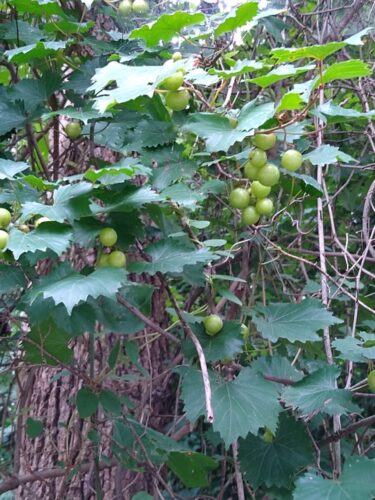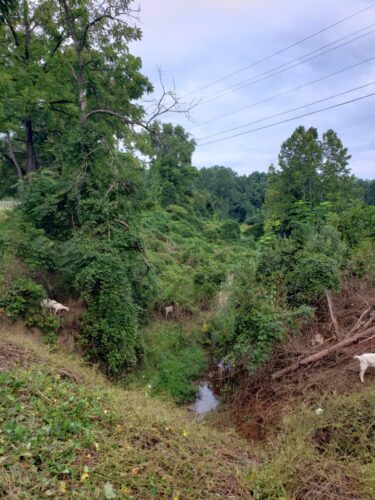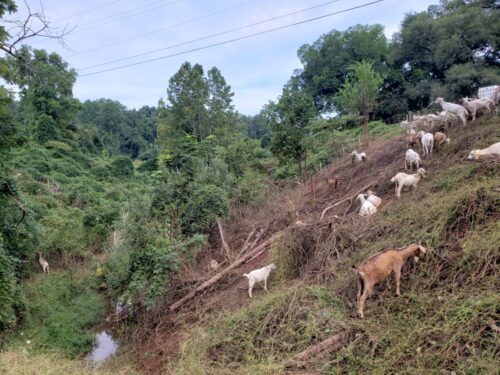The Vine That Ate Charlottesville
September 29, 2021 4:49 pm
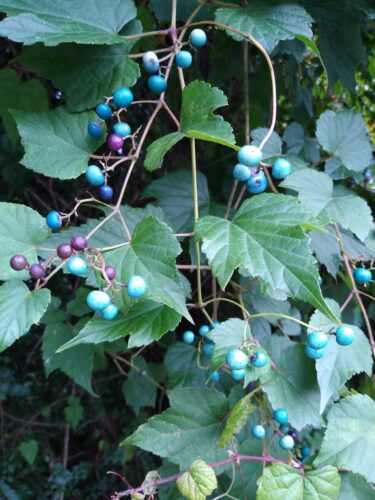
By Ellen Powell, DOF Conservation Education Coordinator
I know what you’re thinking. But no, the vine that ate Charlottesville isn’t kudzu. It’s porcelain-berry (Ampelopsis brevipedunculata).
You might know this species as an ornamental vine, often seen spilling over pergolas in fancy gardens. It’s great for covering a bare patch of ground or an unsightly old shed. The fruits are quite beautiful, with pale green, lavender, magenta, and blue berries often present at the same time.
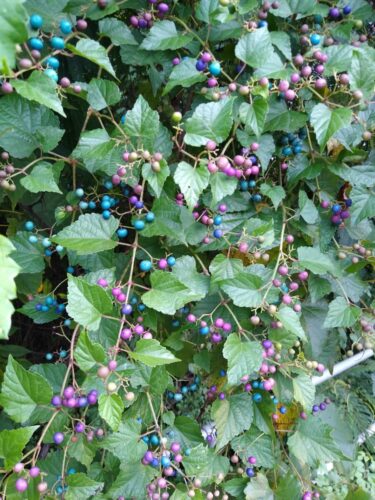
Multicolored fruits of porcelain-berry
Lovely it may be, but porcelain-berry is strangling many of Charlottesville’s wooded areas. Just a few years ago, I would have said the greatest threat to the woods around DOF’s headquarters was Oriental bittersweet (Celastrus orbiculatus). Now a new invasive is scrambling its way to the canopy, robbing trees of light and threatening to snap branches during the next ice storm.
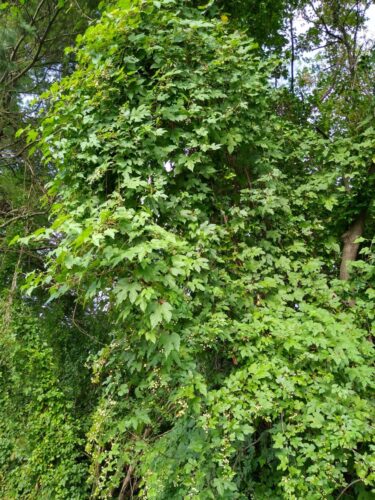
There’s a tree in there somewhere…
I first paid attention to porcelain-berry a few years ago, when I noticed what at first glance appeared to be a kudzu infestation along I-64. On closer inspection, I could see that the vines overtopping trees and other objects looked a lot like wild grape. My theory is that this vine took over Charlottesville by stealth, owing to its resemblance to our native grapes. In fact, they are members of the same family, Vitaceae. Many of us assumed those high-climbing vines were grapes, until we just couldn’t ignore the sheer magnitude of the takeover. Grapevines themselves can be a bit much for some trees to handle, but at least they are a valuable, native wildlife food source. The fact that birds do eat porcelain-berries doesn’t mean they’re that nutritious. As is the case with many invasive species, the fruits are high in carbohydrates, but lower in the proteins and fats that birds need during migration.
How do you tell wild grape from porcelain-berry? Don’t go by the leaves, as they can be pretty similar. The easiest way to distinguish the two is by the flower and fruit clusters. In porcelain-berry, they are held upright, while in grapes, they hang down. Porcelain-berry fruits are also hard, while grapes are juicy. In winter, take a look at the bark on larger stems. Both porcelain-berry and bittersweet have tight bark, while grapevines have shredding bark that peels in lengthwise strips.
- Upright flower clusters of porcelain-berry
- Ripening grapes hanging from stems
The UVA Foundation owns a piece of property along Morey Creek, not far from DOF headquarters. Deya Ramsden, Middle James River Forest Watershed Project Coordinator, approached the foundation last year about managing porcelain-berry and restoring a forested buffer on the property. The buffer project is still in the discussion phase, but at Deya’s advice, the organization has begun working to reduce the amount of porcelain-berry. Their management strategy? Goats!
- Streamside choked in porcelain-berry
- Goats to the rescue!
While grazing goats may not be a feasible option on most home landscapes, vigilance can keep porcelain-berry from taking over. Young vines can be pulled. Older ones can be cut and immediately painted with a herbicide. (If you skip this step, the vines will resprout.) Contact your local Virginia Cooperative Extension office for chemical recommendations, and always follow the label directions. When it comes to pesticides of any sort, the label is the law.
Instead of stuffing porcelain-berry (or bittersweet) vines into your trash, try a bit of “adaptive reuse.” First, remove any berries that might fall off and sprout. Then, twine the vines into a circle to make a wreath. This is best done with newly cut stems that are still flexible, as they break more easily than grapevines. Push the ends into gaps and keep adding pieces of vine until it’s as thick as you want it. The wreath will hold its shape as it dries. I like to stuff grasses and leaves or evergreen cuttings into the gaps between stems to make seasonal wreaths. The wreath forms can be used again and again, and can last for several years, depending on weather. Literally twisting an invasive vine to your own purposes feels like sweet revenge!

Who would guess there’s a porcelain-berry wreath form under that foliage?
Tags: Forest Health Impacts, Invasive Species
Category: Education, Forest Health, Public Information


